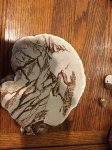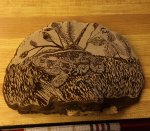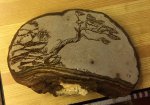You are the opposite of me, in that you are after the conifers up till now. So, I'd recommend that you find a Water, White, or American Elm (all the same tree, different names) or go buy a Discovery Elm if you can find one, although you have to expect to pay $100.00 or more for a tree.
The Discovery Elm has a small leaf and they aren't (or shouldn't be) bud grafted. If it is bud grafted, don't buy it, because you can find ones that aren't. It's a Japanese Elm cultivar (Ulmus davidiana var. japonica 'Discovery'), so it has small leaves,
I don't know if you have Slippery Elm there, but I'd pass on the Siberian Elm if there aren't DEFINATELY Slippery Elm in the area. I suspect that the two hybridize, and may make a passible prospect, but no other Elm species can hybridize with a Water Elm, so IMHO, the Siberian Elm (a true Siberian Elm) is no good... at least you won't see one in my yard... but, I have an abundance of Water Elm to choose from, so I can afford to be picky.
And, IF you have Slippery Elm there, I'd by far choose one of them over a Siberian Elm anyway.
You try those two, and they will teach you a lot... the tricks you learn on them are effective on others, but the Elms are so forgiving.
Most of the rest have their own idiosyncrasies and vary a GREAT deal from one individual tree to another, here are a few rules to follow that might help in your hunt.
- always go looking for a Water or Slippery Elm.
- other tree species will always present themselves, but you'll overlook the Elms if you're looking at others. Elms are easy to find late in the fall because they don't prepare for winter like other tree species do... they keep growing until the first frost nips at the leaves, then they get fall colours... at this time, they will (or should be, or, are likely to be) the only deciduous trees with leaves on them.
- know what you're looking at... by this I mean, if you can't identify it because it's naked, flag it and come back later... you don't want some species. Poplars (drop branches and die without apparent reason), ash (compound leaves) and Manitoba Maples (long internodes and they will drop a major branch for no apparent reason) these are a few right off the top of my head.
- Paper Birch are challenging, mostly because they like wet roots... preferably wet roots with water constantly running through them, and they hate hot roots in the heat of the summer... I'm going to run a copper tubing coil under the roots of one of mine next summer and cycle water through it in Aug. Sept. see if that helps... and they are prone to disease, probably because they are stressed from hot roots.
- most others are worth a try if they don't have compound leaves, but I have a standing rule now that I won't take anything unless it shows tremendous potential right from the start. And then I flag it and come back a time or two before I do anything... oftentimes, I'll find a problem the second or third time that I look at it that I didn't see to begin with, and I don't want anything that I'll regret later.
- beware of hawthorns... one scratch in the eye by a thorn and you'll be blind in that eye for the rest of your life... use a great deal of care if you are going to take one of these.
- Russian Olives are bullet proof, but they have compound leaves. The kids would likely have fun with them... they have thorns as well, but grow like mad!
- Saskatoons for literati style, but I'm not into leggy bonsai, so I'm still on the hunt for a great one.
- Choke Cherry if you can find a great one... but they are illusive and very rare to find a good one, let alone a great one. I have one flagged now "in development in the field", and there are others there that I intend on trying to fuse three together for great nebari and trunk thickness.
- Alder Berry (same as above)
- Wild Plums... difficult to find, protected (like blackberries) by bears when in fruit, a bitch to crawl through to find a good one, but an interesting and fun tree to work on... challenging material. A scratch from a plum will irritate me for weeks afterwards... but I'm allergic to trees. Also have some "in field development"
* Recommend... get an Elm or two, (especially for the kids) leave the rest be until you know what you're after (identification and structure wise) Water Elms can be taken now through spring; but spring is probably best.
For me, I want 5 good, to great trees before retirement. I want 2 good/great trees when I'm 70-75, and I want one great tree when I'm 80-82 and the only wish I have after that is that I want to die before it does.
... sorry for the long post, but I may disappear soon (next couple of days), for some time... good luck on the hunt.




